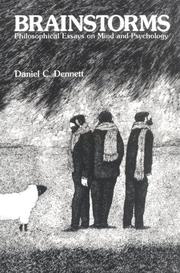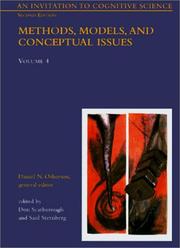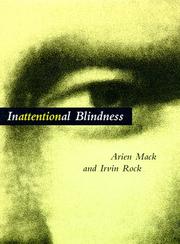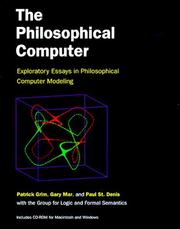| Listing 1 - 6 of 6 |
Sort by
|

ISBN: 0262540371 0262040646 0262271508 0585316007 9780262271509 9780262040648 9780262540377 Year: 1998 Publisher: Cambridge (Mass.) : MIT press,
Abstract | Keywords | Export | Availability | Bookmark
 Loading...
Loading...Choose an application
- Reference Manager
- EndNote
- RefWorks (Direct export to RefWorks)
This collection of 17 essays by the author offers a comprehensive theory of mind, encompassing traditional issues of consciousness and free will. Using careful arguments and ingenious thought-experiments, the author exposes familiar preconceptions and hobbling institutions.This collection of 17 essays by the author offers a comprehensive theory of mind, encompassing traditional issues of consciousness and free will. Using careful arguments and ingenious thought-experiments, the author exposes familiar preconceptions and hobbling institutions. The essays are grouped into four sections: Intentional Explanation and Attributions of Mentality; The Nature of Theory in Psychology; Objects of Consciousness and the Nature of Experience; and Free Will and Personhood.
Psychology --- Philosophy. --- Cognition. --- COGNITIVE SCIENCES/General --- PHILOSOPHY/General --- Mental philosophy --- Humanities

ISBN: 0262650460 026215045X 0262281090 0585053758 9780585053752 9780262281096 0262650452 9780262650458 9780262150453 9780262650465 Year: 1998 Publisher: Cambridge (Mass.) : MIT press,
Abstract | Keywords | Export | Availability | Bookmark
 Loading...
Loading...Choose an application
- Reference Manager
- EndNote
- RefWorks (Direct export to RefWorks)
An Invitation to Cognitive Science provides a point of entry into the vast realm of cognitive science, offering selected examples of issues and theories from many of its subfields. All of the volumes in the second edition contain substantially revised and as well as entirely new chapters.Rather than surveying theories and data in the manner characteristic of many introductory textbooks in the field, An Invitation to Cognitive Science employs a unique case study approach, presenting a focused research topic in some depth and relying on suggested readings to convey the breadth of views and results. Each chapter tells a coherent scientific story, whether developing themes and ideas or describing a particular model and exploring its implications.The volumes are self contained and can be used individually in upper-level undergraduate and graduate courses ranging from introductory psychology, linguistics, cognitive science, and decision sciences, to social psychology, philosophy of mind, rationality, language, and vision science.
Cognitive psychology --- #PBIB:1998.3 --- Cognition. --- Psychology --- Cognitive science. --- NEUROSCIENCE/Visual Neuroscience --- COGNITIVE SCIENCES/General --- Science --- Philosophy of mind

ISBN: 0262133393 0262632039 0262278790 0585003408 9780585003405 9780262133395 9780262632034 9780262278799 Year: 1998 Publisher: Cambridge, Mass. : MIT Press,
Abstract | Keywords | Export | Availability | Bookmark
 Loading...
Loading...Choose an application
- Reference Manager
- EndNote
- RefWorks (Direct export to RefWorks)
Many people believe that merely by opening their eyes, they see everything in their field of view; in fact, a line of psychological research has been taken as evidence of the existence of so-called preattentional perception. In Inattentional Blindness, Arien Mack and Irvin Rock make the claim that there is no such thing - that there is no conscious perception of the visual world without attention to it. The authors present a narrative chronicle of their research. Thus the reader follows the trail that led to the final conclusions, learning why initial hypotheses and explanations were discarded or revised, and how new questions arose along the way. The phenomenon of inattentional blindness has theoretical importance for cognitive psychologists studying perception, attention, and consciousness, as well as for philosophers and neuroscientists interested in the problem of consciousness.
Visual perception. --- Attention. --- Visual discrimination. --- Perception visuelle --- Attention --- Discrimination visuelle --- Visual discrimination --- Visual perception --- #PBIB:1998.3 --- Optics, Psychological --- Vision --- Perception --- Sensory discrimination --- Concentration (Psychology) --- Flow (Psychology) --- Apperception --- Arousal (Physiology) --- Educational psychology --- Memory --- Psychology --- Thought and thinking --- Distraction (Psychology) --- Executive functions (Neuropsychology) --- Interest (Psychology) --- Psychological aspects --- Experimentele psychologie --- geheugen en aandacht --- geheugen en aandacht. --- COGNITIVE SCIENCES/General --- NEUROSCIENCE/Visual Neuroscience

ISBN: 0262071851 0262274337 058503687X 9780585036878 9780262071857 9780262274333 9780262525725 0262525720 0262319306 0262319314 0262527103 1322059799 Year: 1998 Publisher: Cambridge, Mass. MIT Press
Abstract | Keywords | Export | Availability | Bookmark
 Loading...
Loading...Choose an application
- Reference Manager
- EndNote
- RefWorks (Direct export to RefWorks)
An account of the emergence of the mind: how the brain acquired self-awareness, functional autonomy, the ability to think, and the power of speech. "How did the human mind emerge from the collection of neurons that makes up the brain? How did the brain acquire self-awareness, functional autonomy, language, and the ability to think, to understand itself and the world? In this volume in the Essential Knowledge series, Zoltan Torey offers an accessible and concise description of the evolutionary breakthrough that created the human mind. Drawing on insights from evolutionary biology, neuroscience, and linguistics, Torey reconstructs the sequence of events by which Homo erectus became Homo sapiens. He describes the augmented functioning that underpins the emergent mind--a new ('off-line') internal response system with which the brain accesses itself and then forms a selection mechanism for mentally generated behavior options. This functional breakthrough, Torey argues, explains how the animal brain's 'awareness' became self-accessible and reflective--that is, how the human brain acquired a conscious mind. Consciousness, unlike animal awareness, is not a unitary phenomenon but a composite process. Torey's account shows how protolanguage evolved into language, how a brain subsystem for the emergent mind was built, and why these developments are opaque to introspection. We experience the brain's functional autonomy, he argues, as free will. Torey proposes that once life began, consciousness had to emerge--because consciousness is the informational source of the brain's behavioral response. Consciousness, he argues, is not a newly acquired 'quality, ' 'cosmic principle, ' 'circuitry arrangement, ' or 'epiphenomenon, ' as others have argued, but an indispensable working component of the living system's manner of functioning"--MIT CogNet.
Logic --- Philosophy --- Data processing --- Computer simulation --- Philosophy & Religion --- Computer simulation. --- Data processing. --- Argumentation --- Deduction (Logic) --- Deductive logic --- Dialectic (Logic) --- Logic, Deductive --- Mental philosophy --- Intellect --- Psychology --- Science --- Reasoning --- Thought and thinking --- Humanities --- Methodology --- Philosophy - Computer simulation. --- Logic - Computer simulation. --- Philosophy - Data processing. --- Logic - Data processing. --- Cognition. --- Consciousness. --- Brain. --- Cerebrum --- Mind --- Central nervous system --- Head --- Apperception --- Mind and body --- Perception --- Spirit --- Self --- COGNITIVE SCIENCES/General --- COGNITIVE SCIENCES/Psychology/Cognitive Psychology --- Logic - Data processing --- Philosophy - Computer simulation --- Logic - Computer simulation --- Philosophy - Data processing

ISBN: 0262522772 0262024411 0262268272 0585190089 9780585190082 9780262024419 9780262268271 9780262522779 Year: 1998 Publisher: Cambridge, Mass. MIT Press
Abstract | Keywords | Export | Availability | Bookmark
 Loading...
Loading...Choose an application
- Reference Manager
- EndNote
- RefWorks (Direct export to RefWorks)
In this book, Jose Luis Bermudez addresses two fundamental problems in the philosophy and psychology of self-consciousness: (1) Can we provide a noncircular account of full-fledged self-conscious thought and language in terms of more fundamental capacities? (2) Can we explain how full-fledged self-conscious thought and language can arise in the normal course of human development? Bermudez argues that a paradox (the paradox of self-consciousness) arises from the apparent strict interdependence between self-conscious thought and linguistic self-reference. Responding to the paradox, the author draws on recent work in empirical psychology and philosophy to cut the tie between self-conscious thought and linguistic self-reference.
Self (Philosophy) --- Self-consciousness --- Thought and thinking --- Thinking --- Thoughts --- Language, Psychology of --- Psychology of language --- Self-consciousness (Awareness) --- Speculative Philosophy --- Self-consciousness. --- Thought and thinking. --- Experimentele psychologie --- denken, begripsvorming en problem solving --- Self (Philosophy). --- Self-consciousness (Awareness). --- denken, begripsvorming en problem solving. --- Self-awareness --- Psycholinguistics --- Theory of knowledge --- Psycholinguistics. --- Philosophy --- Philosophy & Religion --- Language and languages --- Speech --- Linguistics --- Psychology --- Mind --- Educational psychology --- Intellect --- Logic --- Perception --- Self --- Consciousness --- Psychological aspects --- COGNITIVE SCIENCES/General --- PHILOSOPHY/Philosophy of Mind/General --- Psycholinguistique --- Raisonnement --- Philosophie --- Processus cognitif --- Soi

ISBN: 0262270617 0585077215 0262531631 0262032465 9780262270618 9780585077215 9780262032469 9780262531634 Year: 1998 Publisher: Cambridge, Mass. MIT Press
Abstract | Keywords | Export | Availability | Bookmark
 Loading...
Loading...Choose an application
- Reference Manager
- EndNote
- RefWorks (Direct export to RefWorks)
What is special about the face, and what happens when neurological conditions make expression or comprehension of the face unavailable? Through a mix of science, autobiography, case studies, and speculation, Jonathan Cole shows the importance not only of facial expressions for communication among individuals but also of facial embodiment for our sense of self. Drawing on work in neurology, human development, anthropology, philosophy, and the arts, the book moves from the biological evolution of the face, through the mechanics of expression and perception, to research on the importance of the face in the development of emotion and communication. The heart of the book, though, lies in the experiences of people with facial losses of various kinds. The case studies are of blind, autistic, and neurologically impaired persons; the most extreme case involves Mobius syndrome, in which individuals are born with a total inability to move their facial muscles and hence to make facial expressions. Cole suggests that it is only by studying such personal narratives of loss that we can understand facial function and what all our faces reflect.
Facial expression --- Face --- Physical Examination --- Nonverbal Communication --- Cranial Nerve Diseases --- Head --- Craniocerebral Trauma --- Communication --- Nervous System Diseases --- Wounds and Injuries --- Body Regions --- Diagnostic Techniques and Procedures --- Diseases --- Behavior --- Anatomy --- Diagnosis --- Behavior and Behavior Mechanisms --- Analytical, Diagnostic and Therapeutic Techniques and Equipment --- Psychiatry and Psychology --- Facial Injuries --- Facial Expression --- Facial Nerve Diseases --- Human Anatomy & Physiology --- Health & Biological Sciences --- Physiology --- Movement disorders --- Cranial Nerve VII Disorders --- Facial Nerve Disorders --- Facial Nerve Motor Disorders --- Facial Nerve Sensory Disorders --- Facial Neuritis --- Familial Facial Neuropathy --- Motor Disorders, Facial Nerve --- Sensory Disorders, Facial Nerve --- Seventh Cranial Nerve Diseases --- Acquired Facial Neuropathy --- Cranial Nerve VII Diseases --- Facial Myokymia --- Facial Neuropathy --- Geniculate Ganglionitis --- Acquired Facial Neuropathies --- Disease, Facial Nerve --- Diseases, Facial Nerve --- Disorder, Facial Nerve --- Disorders, Facial Nerve --- Facial Myokymias --- Facial Nerve Disease --- Facial Nerve Disorder --- Facial Neuritides --- Facial Neuropathies --- Facial Neuropathies, Acquired --- Facial Neuropathies, Familial --- Facial Neuropathy, Acquired --- Facial Neuropathy, Familial --- Familial Facial Neuropathies --- Ganglionitides, Geniculate --- Ganglionitis, Geniculate --- Geniculate Ganglionitides --- Myokymia, Facial --- Myokymias, Facial --- Neuritides, Facial --- Neuritis, Facial --- Neuropathies, Facial --- Neuropathies, Familial Facial --- Neuropathy, Facial --- Neuropathy, Familial Facial --- Faces --- Expression, Facial --- Expressions, Facial --- Facial Expressions --- Injuries, Facial --- Facial Injury --- Injury, Facial --- Antemortem Diagnosis --- Diagnoses and Examinations --- Examinations and Diagnoses --- Postmortem Diagnosis --- Antemortem Diagnoses --- Diagnoses --- Diagnoses, Antemortem --- Diagnoses, Postmortem --- Diagnosis, Antemortem --- Diagnosis, Postmortem --- Postmortem Diagnoses --- Disease --- Anatomies --- Acceptance Process --- Acceptance Processes --- Behaviors --- Process, Acceptance --- Processes, Acceptance --- Diagnostic Technics and Procedures --- Technics and Procedures, Diagnostic --- Techniques and Procedures, Diagnostic --- Body Region --- Region, Body --- Regions, Body --- Injuries and Wounds --- Injuries, Wounds --- Research-Related Injuries --- Wounds --- Wounds and Injury --- Wounds, Injury --- Injuries --- Trauma --- Injuries, Research-Related --- Injury --- Injury and Wounds --- Injury, Research-Related --- Research Related Injuries --- Research-Related Injury --- Traumas --- Wound --- Nervous System Disorders --- Neurological Disorders --- Neurologic Disorders --- Disease, Nervous System --- Diseases, Nervous System --- Disorder, Nervous System --- Disorder, Neurologic --- Disorder, Neurological --- Disorders, Nervous System --- Disorders, Neurologic --- Disorders, Neurological --- Nervous System Disease --- Nervous System Disorder --- Neurologic Disorder --- Neurological Disorder --- Communication Programs --- Communications Personnel --- Misinformation --- Personal Communication --- Communication Program --- Communication, Personal --- Personnel, Communications --- Program, Communication --- Programs, Communication --- Craniocerebral Injuries --- Crushing Skull Injury --- Forehead Trauma --- Head Injuries, Multiple --- Head Injury, Minor --- Head Injury, Open --- Head Injury, Superficial --- Injuries, Craniocerebral --- Injuries, Head --- Multiple Head Injuries --- Occipital Trauma --- Open Head Injury --- Superficial Head Injury --- Trauma, Head --- Frontal Region Trauma --- Head Injuries --- Head Trauma --- Occipital Region Trauma --- Parietal Region Trauma --- Temporal Region Trauma --- Craniocerebral Injury --- Craniocerebral Traumas --- Crushing Skull Injuries --- Forehead Traumas --- Frontal Region Traumas --- Head Injuries, Minor --- Head Injuries, Open --- Head Injuries, Superficial --- Head Injury --- Head Injury, Multiple --- Head Traumas --- Injuries, Minor Head --- Injuries, Multiple Head --- Injuries, Open Head --- Injuries, Superficial Head --- Injury, Craniocerebral --- Injury, Head --- Injury, Minor Head --- Injury, Multiple Head --- Injury, Open Head --- Injury, Superficial Head --- Minor Head Injuries --- Minor Head Injury --- Multiple Head Injury --- Occipital Region Traumas --- Occipital Traumas --- Open Head Injuries --- Parietal Region Traumas --- Region Trauma, Frontal --- Region Trauma, Occipital --- Region Trauma, Parietal --- Region Traumas, Frontal --- Region Traumas, Occipital --- Region Traumas, Parietal --- Skull Injuries, Crushing --- Skull Injury, Crushing --- Superficial Head Injuries --- Temporal Region Traumas --- Trauma, Craniocerebral --- Trauma, Forehead --- Trauma, Frontal Region --- Trauma, Occipital --- Trauma, Occipital Region --- Trauma, Parietal Region --- Trauma, Temporal Region --- Traumas, Craniocerebral --- Traumas, Forehead --- Traumas, Frontal Region --- Traumas, Head --- Traumas, Occipital --- Traumas, Occipital Region --- Traumas, Parietal Region --- Traumas, Temporal Region --- Heads --- Cranial Nerve Disorders --- Cranial Nerve Palsies --- Nervus Cranialis Disorders --- Cranial Neuropathies --- Cranial Neuropathies, Multiple --- Neuropathies, Cranial --- Cranial Nerve Disease --- Cranial Nerve Disorder --- Cranial Nerve Palsy --- Cranial Neuropathy --- Cranial Neuropathy, Multiple --- Multiple Cranial Neuropathies --- Multiple Cranial Neuropathy --- Nervus Cranialis Disorder --- Neuropathies, Multiple Cranial --- Neuropathy, Cranial --- Neuropathy, Multiple Cranial --- Palsies, Cranial Nerve --- Palsy, Cranial Nerve --- Communication, Nonverbal --- Communications, Nonverbal --- Nonverbal Communications --- Examination, Physical --- Physical Examinations and Diagnoses --- Examinations, Physical --- Physical Examinations --- Human face --- Facial expressions --- injuries --- diagnosis --- methods --- Expression --- Physiognomy --- Sensitivity and Specificity --- First Aid --- Traumatology --- Neurology --- Optic Nerve Injuries --- Olfactory Nerve Diseases --- Meningitis, Cryptococcal --- Neuroaspergillosis --- Surgical Clearance --- Independent Medical Evaluation --- Pathognomy --- Body language --- #SBIB:309H53 --- #SBIB:AANKOOP --- 800.95 --- 800.95 Non-verbale communicatie --- Non-verbale communicatie --- Facial dyskinesias --- Facial movement disorders --- Niet-verbale communicatie --- Developmental psychology --- Affective and dynamic functions --- Facial expression. --- Movement disorders. --- Physical Exam --- Exam, Physical --- Exams, Physical --- Physical Exams --- NEUROSCIENCE/General --- COGNITIVE SCIENCES/General
| Listing 1 - 6 of 6 |
Sort by
|

 Search
Search Feedback
Feedback About UniCat
About UniCat  Help
Help News
News